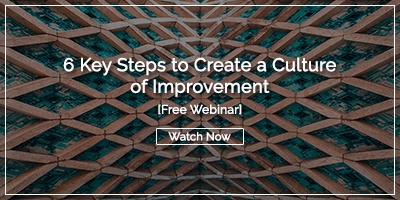 Every organization that embarks on a journey toward continuous quality improvement is unique. Leaders in every industry, from healthcare to construction, have set CQI as a goal. Some organizations use a business management method, such as Six Sigma or Lean, while others take a less formal approach.
Every organization that embarks on a journey toward continuous quality improvement is unique. Leaders in every industry, from healthcare to construction, have set CQI as a goal. Some organizations use a business management method, such as Six Sigma or Lean, while others take a less formal approach.
While differences abound, there is a set of guiding principles that unifies those interested in achieving continuous improvement and enjoying the benefits it brings. We've also included a list of proven tools that make CQI achievable for any team. Regardless of the mission of your organization, these ideas can be applied.
What Are the Core Principles of Continuous Quality Improvement
Understanding the foundational principles of CQI is crucial before implementing any tools or techniques. These principles create the framework that guides all improvement activities and ensures long-term success.
Incremental Change Drives Lasting Results
Organizations dedicated to CQI believe that positive change will result from small changes, not major revolutions or new inventions. They aren’t waiting for some big idea that will make everything better. Instead, they know that improvement happens one small step at a time. Change does not have to be scary or destabilizing. By focusing on little changes that occur often, the reluctance to change is minimized, and improvement happens faster. Change becomes part of the culture and an everyday exercise rather than a big event that will happen some other day.
Employee Empowerment Creates Innovation
Continuous quality improvement holds that the people who are in the best position to recognize opportunities for improvement are those on the front lines. One does not need a seat in the board room to recognize waste, identify quality problems, respond to customer needs, and practice innovation. Those who work most closely with products, customers, and partners are in precisely the right spot to identify and implement opportunities for improvement.
Clear Goals Provide Direction
Continuous quality improvement requires a unity of purpose. Without a clear definition of the long-term mission and goals of the organization, often called “True North,” it is impossible to say whether the organization is improving or not. Once the strategic vision is clear, the overall goals of the organization can be broken down into the department, team, and individual levels. This helps people understand where they fit into the bigger picture. It also simplifies decisions and makes it easy to set priorities. When an opportunity for improvement is submitted, it can be assessed based on its relationship to the goals.
Respect for People Enables Excellence
Continuous quality improvement is about creating an environment in which every person can do their best work. Flaws in processes, not people, almost always cause problems. Leaders who are practicing CQI value the creativity and engagement of each employee. When people contribute to positive change, they are acknowledged and thanked for their efforts. One aspect of respect is support. Employees should have the tools, training, and time they need to engage in improvement.
Dynamic Standards Support Growth
It is impossible to know whether you’ve achieved improvement if you don’t have a baseline for comparison. That’s why Standard work is so important. Standard work is the current best practice for doing any task. The Standard is used by everyone operating the process. Results can be measured and are predictable. Once the Standard is in place, improvements can be implemented and measured. If the change is successful, a new Standard is adopted, and the process can begin again. This improvement cycle is often supported by the PDSA or DMAIC improvement method.
Visual Management Accelerates Understanding
The quickest way for someone to understand the current state of a process or the results it produces is through images. That’s why there are so many continuous quality improvement tools that support visual management. Among them are control charts, huddle boards, Kanban signs, wallboards, and color-coded status indicators. People recognize and process images far more quickly and thoroughly than text, so these tools are enormously beneficial. Modern organizations turn to cloud-based digital tools that can be widely adopted and accessed 24x7 from anywhere on any device.
Which Tools Are Most Effective for Implementing CQI?
The right tools make CQI accessible and sustainable for teams across all industries. These proven techniques provide structure for improvement efforts while remaining flexible enough to adapt to different organizational contexts.
Implement Standard Work
Standard work documents represent the current best practice for performing any task or process. These living documents serve as improvement baselines and should include:
- Step-by-step procedures created by process operators themselves
- Visual aids including diagrams, photographs, and quality checkpoints
- Easy accessibility where work occurs with regular updates as improvements are implemented
- Consistent measurement points enabling accurate assessment of change effectiveness
- Process documentation that prevents improvement efforts from lacking baseline comparisons
Try the 5 Whys
It is critical to remember that lasting quality improvement comes from addressing the root causes of problems rather than applying Band-aids or workarounds. The 5 Whys is a simple yet powerful method for doing just that. Leaders and process operators state the problem and ask Why until the root cause is revealed. The number of times you have to ask why will vary based on the complexity of the process and the problem, but usually, about five will get you there.
Use a Structured Quality Improvement Method
Organizations use several structured improvement cycles to implement quality improvement. For example, DMAIC (Define, Measure, Analyze, Improve, Control) is popular with organizations that have implemented Six Sigma and are interested in statistical control, and PDSA offers a more straightforward approach to implementing and evaluating improvements.
Selecting between PDSA and DMAIC depends on organizational context and project requirements:
PDSA is ideal for:
- Organizations beginning CQI journeys without extensive statistical backgrounds
- Problems with limited data requirements or straightforward solutions
- Rapid improvement cycles requiring quick implementation and feedback
- Employee engagement focus emphasizing participation over statistical rigor
- Simple process improvements with clear cause-and-effect relationships
DMAIC works best for:
- Organizations with mature data collection capabilities and statistical expertise
- Complex processes requiring statistical analysis to understand variation sources
- High-stakes improvements where thorough analysis justifies longer timelines
- Six Sigma implementations requiring statistical process control
- Projects needing rigorous validation before large-scale implementation
Both methods ensure systematic approaches to improvement while providing frameworks for measuring success and maintaining gains over time.
Play Catchball
During the Plan phase of PDSA, the practice of Catchball can be a helpful way to generate ideas and gather feedback from the team. The technique starts when someone (usually a manager, but not always) offers an idea for process improvement or a statement of the problem. It is then “passed” back and forth between leaders, front-line workers, internal customers, and others interested in the outputs from the process. Moving the idea around without a strict hierarchy of decision-makers increases employee engagement and improves the original notion.
Leverage Process Control Charts

Control charts are a handy tool during the Study phase of PDSA. They help you identify trends and variance as you examine your quality results. Data is plotted in a time-ordered sequence on a chart that has a midline for the average results and upper and lower control limits. You should expect to see some variance within limits, but results above or below the control lines generally require attention. They may represent unexpected variations in the process. The charts help you identify trends that may indicate a change has resulted in improvement or something going wrong.
Practice Gemba Walks
Gemba Walks are a practice borrowed from the Lean business methodology. During a Gemba Walk, the leader visits the workspace to ask questions, observe activities, and, most importantly, show respect for employees. Change is not implemented during a Gemba Walk, nor is the walk used for employee performance evaluation. Instead, it serves as a potential starting point for a PDSA cycle and an opportunity for process operators to share their thoughts on each process element.
Create a Value Stream Map
A common reason for quality problems is that, over time, processes become unnecessarily complex, introducing increasing opportunities for error. Value stream mapping is a useful way of identifying activities and materials that don’t add value to the customer. Eliminating this waste allows you to streamline your process and focus on achieving excellent quality for the elements you do need.
Leverage Fishbone Diagrams
The 5 Whys technique is helpful for many issues; more complex problems may require a more structured approach to problem-solving. Fishbone diagrams are an approach that breaks down potential root causes into common categories and encourages the team to explore each one. While the categories can vary based on the nature of your organization and its products, the most common categories are materials, environment, equipment, management, people, and measurement. The diagram looks something like the skeleton of a fish, with the problem as the head and each of the categories as a bone.

Hold a Rapid Improvement Event
In general, we think that daily, incremental improvements are the surest path to success. Still, sometimes the quality of process results is such that more urgent and immediate action is needed. In that case, a rapid improvement event can lead to a quick solution. During an improvement event, a team including the process operators, subject matter experts, leaders, and other stakeholders puts aside their regular duties for a three to five-day focused quality improvement effort. This allows for an accelerated PDSA cycle. Leadership is crucial during an event of this sort, so selecting a skilled facilitator to guide the effort is essential.
Implement Quality Improvement Software
While improvement events are great, operationally excellent organizations know that quality improvement is a long-term ever-lasting effort. That’s why they frequently invest in software tools to structure and organize their improvement efforts. Quality improvement software allows employees to easily suggest opportunities for improvement, which are routed to managers for review. Once an improvement project begins, the solution provides the necessary workflow for making sure forward progress is maintained. It also measures the impact of change against quality goals. With a documented knowledge repository, the team gets smarter with every improvement.
Building a Culture of Continuous Quality Improvement
Embedding continuous quality improvement (CQI) into an organization’s DNA requires a deliberate and sustained effort. It begins with creating an environment where feedback flows freely, and employees at all levels feel empowered to suggest improvements. Leaders play a crucial role in this transformation by modeling the behaviors they want to see, such as a willingness to experiment, learn from failure, and celebrate success. Providing training, resources, and time for employees to engage in CQI activities further solidifies this commitment. Over time, as small changes accumulate and lead to meaningful results, CQI becomes a natural part of the organization’s culture.
Leadership is also instrumental in fostering a culture of respect and collaboration. When leaders actively listen to employee ideas and show appreciation for their contributions, it signals that CQI is a shared responsibility, not a top-down mandate. By embedding continuous improvement into the organization’s values, strategies, and daily operations, teams become more engaged, processes become more efficient, and the organization becomes better equipped to adapt to an ever-changing environment.
Conclusion: The Journey Towards Excellence
The pursuit of excellence through continuous quality improvement is a journey. By embracing the principles and tools discussed in this post—such as incremental change, respect for people, clear goals, and structured methodologies—organizations can reach their full potential. CQI doesn’t demand perfection overnight but instead calls for consistent, thoughtful efforts that lead to measurable and sustainable progress.
Whether your organization is just starting its CQI journey or refining its existing approach, the key is to take the first step. Start small, focus on building momentum, and involve everyone in the process. Over time, these efforts will yield a stronger, more resilient organization capable of delivering exceptional value to its customers, employees, and stakeholders.
Frequently Asked Questions
What is the difference between CQI and traditional quality control?
Traditional quality control focuses on detecting and correcting defects after they occur, while CQI emphasizes preventing problems through continuous process improvement and employee engagement.
Why is standard work important in CQI?
Standard work provides the consistent baseline needed to measure improvement effectiveness. Without standardized processes, it's impossible to determine whether changes create genuine improvements.
How does the PDSA cycle improve processes?
PDSA provides a systematic framework for testing improvements on a small scale, evaluating results, and implementing successful changes while avoiding the risks associated with large-scale process modifications.
What software features support continuous quality improvement?
Key features include idea submission systems, workflow management, impact tracking, visual dashboards, knowledge repositories, and integration capabilities with existing organizational systems.
How do I start building a CQI culture?
Begin by securing leadership commitment, providing employee training, implementing basic improvement tools like standard work and PDSA, and celebrating early wins to build momentum for larger cultural changes.



Add a Comment